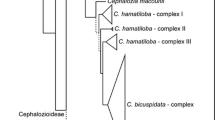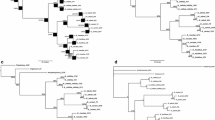Abstract.
Representatives of nearly all genera of the taxon-rich stem-succulent stapeliads and most of the few related, leafy genera were analyzed. Sequence data from two non-coding molecular markers (ITS region of nrDNA and trnT-L and trnL-F spacers as well as the trnL intron of cpDNA) support the traditional tribal affiliation of the genera, which form a monophyletic group. This monophylum breaks into a basal Neoschumannia/Anisotoma/Riocreuxia/Sisyranthus nk;clade, from which the core Ceropegieae are derived. The four Ceropegia species included are not monophyletic, and their relationship to Brachystelma changes depending on the marker studied. The stem succulent taxa fall in a number of well supported, but unresolved clades, the most prominent being the predominantly southern African clade comprising Orbea, Stapelia and some other genera. The most derived taxa of NE Africa, Duvaliandra and White-sloanea, are basal to this southern African clade. The other clades comprise the more basal genera of stem-succulent stapeliads, including the members of the Caralluma complex. Of the 17 genera accepted by Plowes for the Caralluma complex, seven are recognized: Caralluma, Apteranthes, Australluma, Boucerosia, Caudanthera, Desmidorchis and Monolluma. New combinations are proposed in 15 cases; Caralluma adscendens var. geniculata is raised to specific rank. Anomalluma is reinstated, and Pseudolithos mccoyi is transfered to it. A broadened concept for Orbea (incl. Angolluma and Orbeopsis) is recognized, but Orbeanthus is kept separate. The monotypic Ballyanthus, recently separated from Orbea, is nested within Duvalia. Piaranthus (incl. Huerniopsis) is monophyletic. The bitypic Notechidnopsis is reduced to the type species, N. tessellata, while N. columnaris is transferred to a new genus, Richtersveldia.
Similar content being viewed by others
Author information
Authors and Affiliations
Additional information
Received February 25, 2002; accepted June 17, 2002 Published online: November 7, 2002
Address of the authors: Dr. Ulrich Meve (e-mail: ulrich.meve@uni-bayreuth.de) and Prof. Dr. Sigrid Liede (e-mail: sigrid.liede@uni-bayreuth.de), Universität Bayreuth, Lehrstuhl für Pflanzensystematik, Universitätsstrasse 30, D-95440 Bayreuth, Germany.
Rights and permissions
About this article
Cite this article
Meve, U., Liede, S. A molecular phylogeny and generic rearrangement of the stapelioid Ceropegieae (Apocynaceae-Asclepiadoideae). Plant Syst. Evol. 234, 171–209 (2002). https://doi.org/10.1007/s00606-002-0220-2
Issue Date:
DOI: https://doi.org/10.1007/s00606-002-0220-2




